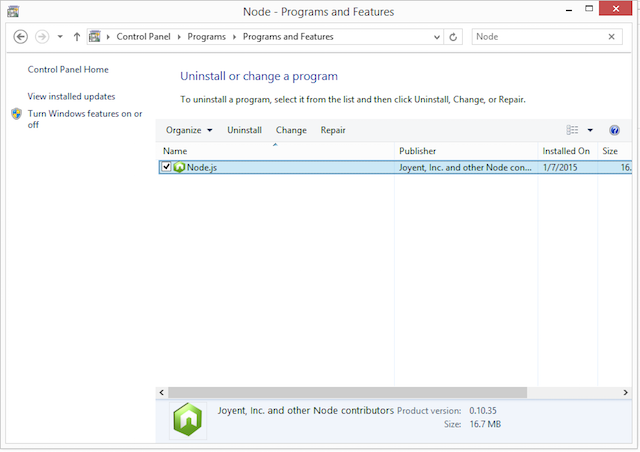

- #Remove node js mac how to
- #Remove node js mac install
- #Remove node js mac full
- #Remove node js mac download
So, if you now run: nvm use awesome-version You’re setting an alias with the name “awesome-version” for Node.js version 13.6.0. For example, by running: nvm alias awesome-version 13.6.0 You can also create custom aliases beyond the ones that come with nvm. When switching to a different version, nvm will make the node instance in your terminal symlink to the proper Node.js instance. Switch to the latest LTS version: nvm use -lts Switch to the latest Node.js version: nvm use node Switch to Node.js version 12.14.1: nvm use 12.14.1 Switch to Node.js version 13.6.0: nvm use 13.6.0 So, you need to follow this by a version number or an alias.
#Remove node js mac install
This works similarly to the install command. To switch through installed versions, nvm provides the nvm use command. So if you install the latest Node.js version, and run node -v right after, you’ll see the latest version output. Let me first note that when a new version is installed, it’s automatically put to use.
#Remove node js mac how to
Now let’s go through how to switch between them. So far, we’ve seen how to install different Node versions. You can also uninstall any instance you no longer think is useful, by running: nvm uninstall 13.6.0 This will currently pull in version 12.14.1. Or you can install the most recent LTS release, using: nvm install -lts This will currently pull in version 13.6.0. If you’re not sure what the latest version is, you can use the node alias: nvm install node For example: nvm install v12.14.1 -reinstall-packages-from = 10.18.1īy running the above, nvm will install Node.js version 12.14.1, the corresponding npm version, and reinstall the global npm packages you had installed for the 10.18.1 version. This has the added advantage that users won’t require sudo privileges to install global packages.įortunately, when installing a new Node.js version, you can reinstall the npm global packages from a specific version. Rather, they’re installed alongside the current Node version in ~/.nvm/versions/node//lib/node_modules. Globally installed npm packages aren’t shared among different Node.js versions, as this could cause incompatibilities. Each Node version might bring a different npm version, and you can run npm -v to check which one you’re currently using.

When installing a Node.js instance, nvm will also install a compatible npm version. For example, nvm ls-remote | less, or nvm ls-remote | grep v12. Linux users might like to qpipe that to less or grep the version they’re after. Tip: Listing all available Node versions produces a lot of output.
#Remove node js mac full
You can see the full list of available versions by running: nvm ls-remoteįor nvm-windows, this is: nvm ls available At the time of writing, this is 1, so you’ll have the 12.14.1 version installed on your system. Nvm will then install Node.js version 12.14.X, where X is the highest available version. Nvm follows SemVer, so if you want to install, for example, the latest 12.14 patch, you can do it by running: nvm install 12.14 Tip: nvm-windows users will have to run nvm use 12.14.1 after installing. For example: nvm install 12.14.1īy running the above in a terminal, nvm will install Node.js version 12.14.1. You can install specific versions by running this command followed by the version you want. For this, nvm provides the nvm install command. One of the most important parts of nvm is, of course, installing different versions of Node.js. Let’s see how to use it to manage Node.js versions. If installed correctly, the nvm command is available anywhere in you terminal. This will clone the nvm repository to ~/.nvm and will make the required changes to your bash profile, so that nvm is available from anywhere in your terminal.Īnd that’s it! Reload (or restart) your terminal and nvm is ready to be used. Note that the version number ( v0.35.2) will change as the project develops, so it’s worth checking the relevant section of project’s home page to find the most recent version. And here’s how you can remove any previous npm installation you might have. For example, here’s how to remove Node on macOS and on Linux. If this is something you want to do, there are plenty of good resources available online. Unlike Windows, removing previous Node and npm installations in macOS and Linux is optional.
#Remove node js mac download



 0 kommentar(er)
0 kommentar(er)
